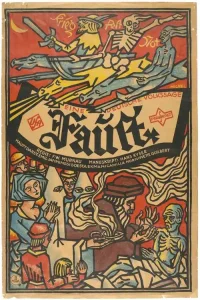Symphony of Sin & Salvation: How F.W. Murnau's 'Faust' (1926) Forged a Hellish Masterpiece of Silent Cinema!
In the hallowed halls of German Expressionist cinema, F.W. Murnau stands as an undisputed titan, a director whose films were not merely stories but profound visual poems that delved into the spiritual and psychological depths of the human condition. Hot on the heels of his seminal Nosferatu and The Last Laugh, Murnau undertook his most ambitious project yet: Faust (Faust Eine Deutsche Volkssage, 1926), a monumental adaptation of the classic German legend, primarily drawing from Goethe's tragic masterpiece. This film wasn't just an interpretation; it was a grand, operatic spectacle, a breathtaking fusion of epic scale, unparalleled special effects, and a haunting exploration of good versus evil, temptation, and redemption. Faust cemented Murnau's legacy as a visual innovator and a master storyteller, proving silent cinema's immense power to conjure worlds of profound moral struggle and ethereal beauty, making it an enduring, essential cult classic for all cinephiles.
The film plunges us into an eternal battle between the Archangel and the demon Mephisto (Emil Jannings), who makes a diabolical wager over the soul of humanity. Mephisto boasts he can corrupt any man, and the target chosen is the venerable, elderly scholar Faust (Gösta Ekman), a man weary of life's limitations. Mephisto unleashes a plague upon Faust's town, and when Faust's attempts to cure the suffering fail, he despairingly signs a pact with the devil, gaining youth, power, and the ability to save his people. What follows is a tragic, visually stunning descent into temptation, as Faust indulges in earthly pleasures, falls in love with the innocent Gretchen (Camilla Horn), and inadvertently brings about her ruin. Murnau crafts a narrative that is both a grand cosmic struggle and an intimately human tragedy, exploring the profound cost of forbidden desires and the eternal quest for salvation.
F.W. Murnau's directorial genius is on full, breathtaking display throughout Faust, pushing the boundaries of silent film technique to an unprecedented degree. The film is a masterclass in German Expressionist aesthetics, utilizing stark, dramatic lighting, colossal, stylized sets (most notably Mephisto's towering figure casting a shadow over the town), and groundbreaking special effects that remain astonishing even today. The famous opening sequence, with Mephisto's gargantuan shadow looming over a miniature village, or Faust's flight through the skies on Mephisto's cloak, are iconic examples of visual poetry achieved through masterful optical illusions and camera trickery. Emil Jannings delivers a captivating, deliciously sinister performance as Mephisto, embodying pure, seductive evil. Gösta Ekman's transformation from aged scholar to youthful lover is equally compelling, and Camilla Horn brings a tragic innocence to Gretchen. It's a technical marvel and a deeply moving spiritual journey, a testament to Murnau’s unparalleled skill in cinematic storytelling.
Director: F.W. Murnau.
Cast: Gösta Ekman as Faust, Emil Jannings as Mephisto, and Camilla Horn as Gretchen.
Special Info/Trivia: This film is a monumental example of German Expressionist cinema, known for its stunning visuals and groundbreaking special effects for the silent era. It is based on the classic German legend of Faust, primarily inspired by Goethe's version. Emil Jannings (who later won the first Academy Award for Best Actor) delivers an iconic performance as Mephisto. The film was a very expensive production for UFA studios, intended as a showpiece. Murnau's use of optical effects and miniature work for scenes like Mephisto flying over the town were revolutionary.

